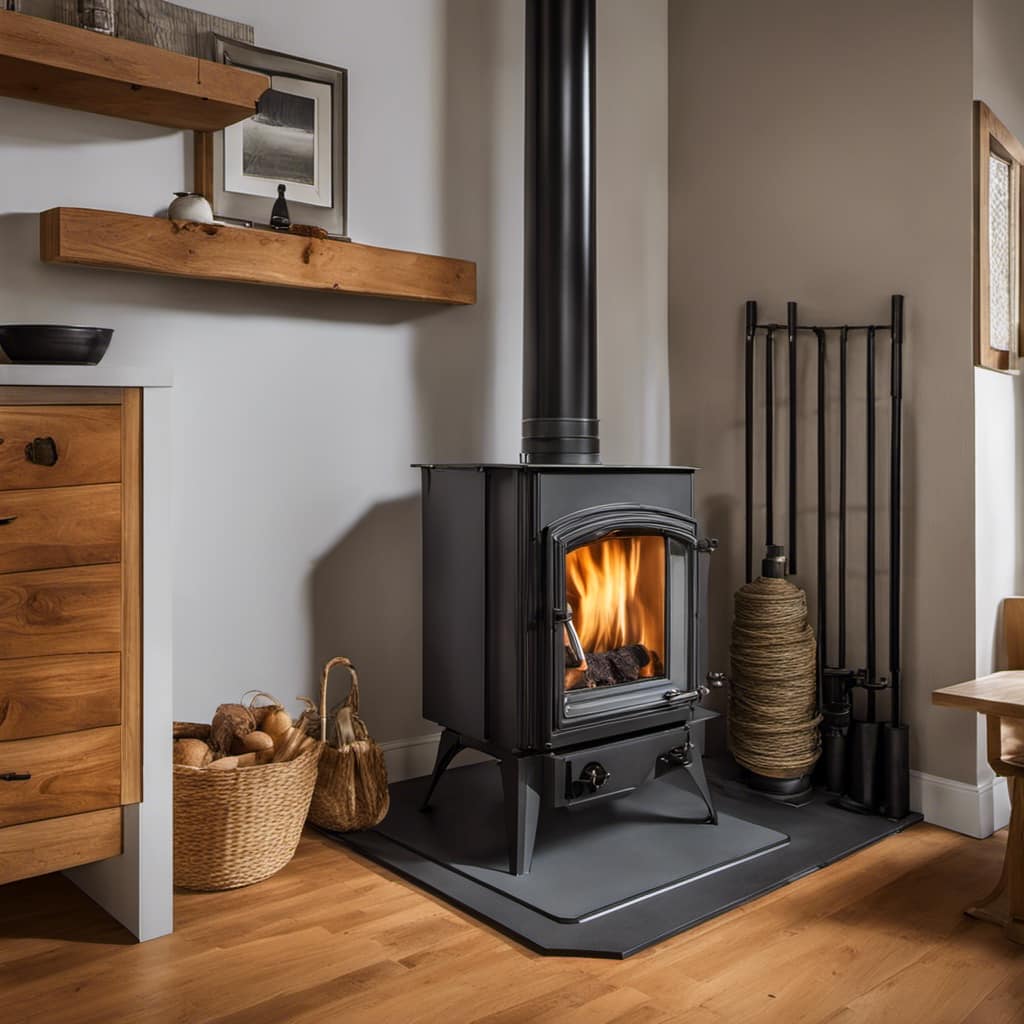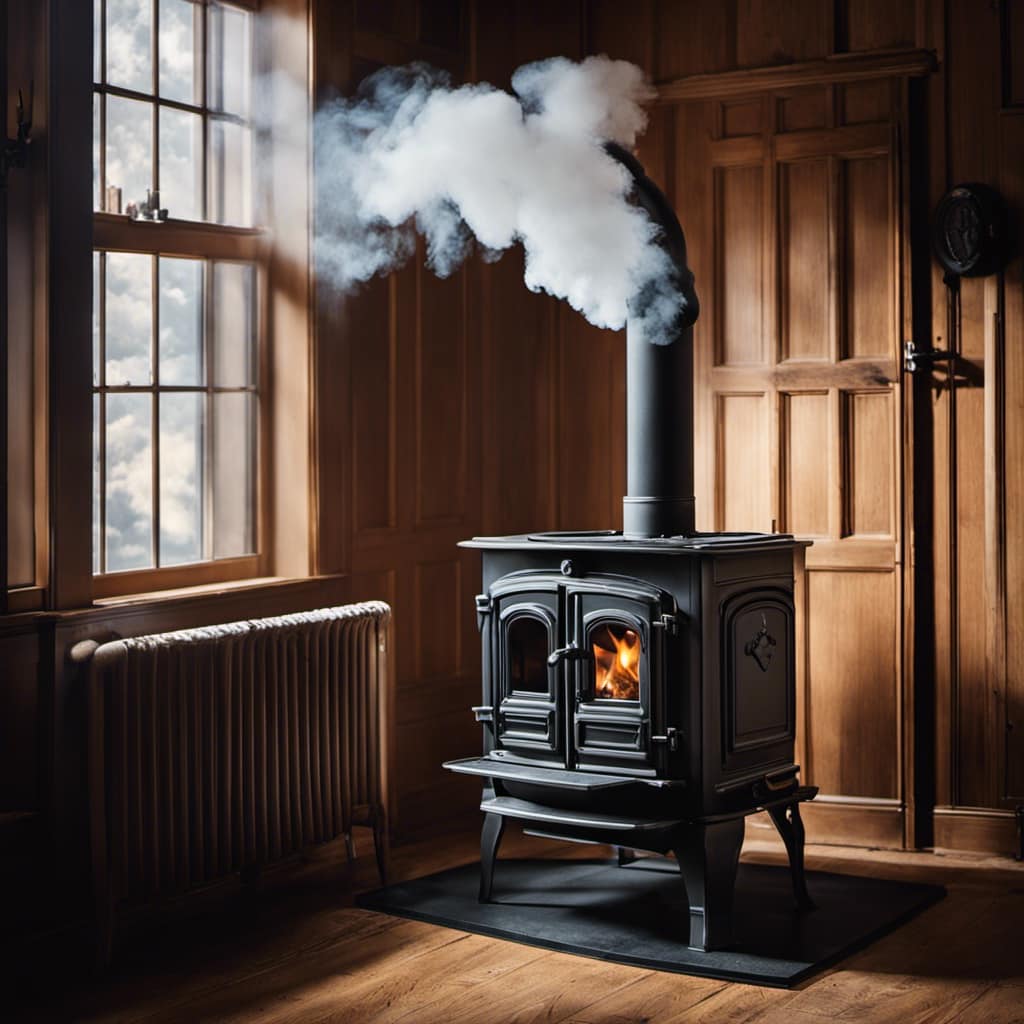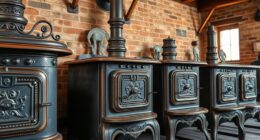As a homeowner with a wood-burning stove, I encountered a problem when I realized that the stove pipe was too short. It felt like I was trying to solve a puzzle with missing pieces, as I needed to find a way to extend it.
After thorough research and trial and error, I discovered the best methods and tools to extend a wood stove pipe. In this article, I will share my knowledge, guiding you through the process step by step, ensuring a proper and efficient installation.
Key Takeaways
- A longer wood stove pipe can improve efficiency by enhancing draft and reducing smoke inside the house.
- However, it may also lead to creosote buildup, increasing the risk of chimney fires.
- Additional support may be needed for stability and to prevent leakage.
- It is important to consider the potential risks and drawbacks before investing in a longer wood stove pipe, weighing factors such as efficiency improvement versus creosote buildup and stability.
Assessing the Need for a Longer Wood Stove Pipe
I’m considering whether I should invest in a longer wood stove pipe for my home. When evaluating alternative heating options, it’s important to understand the potential risks and drawbacks of a longer wood stove pipe.
While a longer pipe can help in increasing the efficiency of the wood stove by creating better draft and reducing the amount of smoke inside the house, it also comes with certain considerations.

Firstly, the longer the pipe, the more chance there’s for creosote buildup, which can lead to chimney fires. Additionally, a longer pipe may require additional support to ensure stability and prevent leakage.
It’s crucial to weigh these factors before deciding to invest in a longer wood stove pipe. Moving forward, I’ll now discuss the different extension methods available for wood stove pipes, which will help in choosing the right option for my home.
Choosing the Right Extension Method for Your Wood Stove Pipe
There are various extension methods to consider when choosing the right option for my wood stove pipe. The first step is to assess the need for a longer pipe and determine the appropriate length. Once that’s established, I must choose the right materials for the extension.
It’s crucial to select materials that can withstand high temperatures and are compatible with the existing pipe. Stainless steel is a popular choice due to its durability and resistance to corrosion. However, it’s essential to follow manufacturer guidelines and consult with professionals to ensure proper installation and minimize potential risks.

Precautions should also be taken to ensure a tight and secure connection, such as using high-temperature sealant and properly securing clamps. By choosing the right materials and taking necessary precautions, I can safely lengthen my wood stove pipe.
Gathering the Necessary Tools and Materials for Lengthening a Wood Stove Pipe
To successfully lengthen my wood stove pipe, I need to gather the necessary tools and materials for the job. Some common mistakes to avoid when lengthening a wood stove pipe include using improper materials, not considering the proper angle of the pipe, and neglecting to secure the connections properly. Understanding the importance of proper ventilation when extending a wood stove pipe is crucial to ensure the safe and efficient operation of the stove.
When gathering the necessary tools and materials, it’s important to have the following items on hand:
- Appropriate length of stove pipe
- Pipe sections or couplings
- High-temperature silicone sealant
- Pipe clamps or screws
- Fireproof insulation
Step-by-Step Guide to Extending the Length of Your Wood Stove Pipe
I carefully followed the step-by-step guide to effortlessly extend the length of my wood stove pipe.

First, I measured the existing pipe and determined the necessary length for the extension.
Next, I obtained a matching pipe section and ensured it was the correct size and material for my wood stove.
I then cleaned both ends of the existing pipe and the new section to remove any debris or soot.
Using high-temperature silicone sealant, I securely connected the two sections together.

To prevent heat loss and improve efficiency, I insulated the wood stove pipe with fiberglass insulation.
Finally, I installed a chimney cap to prevent rain, debris, and animals from entering the pipe.
Following these steps, I successfully extended the length of my wood stove pipe.
Ensuring Proper Installation and Maintenance of Your Extended Wood Stove Pipe
I always make sure to regularly inspect and clean my extended wood stove pipe to maintain its proper installation and prevent any potential issues. When it comes to ensuring the longevity and efficiency of your extended wood stove pipe, proper maintenance is key. Here are some important points to keep in mind:

- Regularly inspect the pipe for any signs of wear and tear, such as cracks or loose connections.
- Clean the pipe regularly to remove any built-up creosote or debris, which can restrict airflow and increase the risk of chimney fires.
- Check the insulation around the pipe to ensure it’s intact and properly installed, as this helps prevent heat loss and improves overall efficiency.
- Monitor the draft and smoke output to troubleshoot common issues such as poor combustion or inadequate ventilation.
- Consider consulting a professional if you encounter any major issues or if you’re unsure about any aspect of the installation or maintenance process.
Frequently Asked Questions
Can I Use Any Type of Pipe to Lengthen My Wood Stove Pipe?
Yes, you can use different types of pipes to lengthen a wood stove pipe. However, it’s important to consider the pros and cons of each material, such as durability, heat resistance, and compatibility with your wood stove.
How Can I Determine the Appropriate Length for My Extended Wood Stove Pipe?
To determine the appropriate length for my extended wood stove pipe, I use precise measuring techniques. By taking into account factors such as clearance requirements and the distance to combustible materials, I ensure a safe and efficient installation.
Are There Any Safety Precautions I Should Take When Extending My Wood Stove Pipe?
When extending a wood stove pipe, it is crucial to prioritize safety. Common mistakes include using incorrect materials or not following proper installation guidelines. Always consult a professional and adhere to local building codes for a safe and effective extension.
Can I Install a Longer Wood Stove Pipe Myself, or Should I Hire a Professional?
I can definitely install a longer wood stove pipe myself, but let’s be honest, it’s not rocket science. However, if you want to avoid any mishaps or potential disasters, it might be wise to hire a professional. Safety first, folks.

How Often Should I Inspect and Clean My Extended Wood Stove Pipe to Ensure Optimal Performance?
I should inspect and clean my extended wood stove pipe regularly to maintain optimal performance. Signs that it needs cleaning include decreased efficiency, excessive smoke, and creosote buildup.
Conclusion
In conclusion, lengthening a wood stove pipe requires careful assessment, appropriate extension methods, and the right tools and materials. By following a step-by-step guide and ensuring proper installation and maintenance, you can safely extend the length of your wood stove pipe.
So, don’t let a short pipe limit your heating potential – with a little effort, you can reach new heights of warmth and comfort in your home!
Growing up surrounded by the vast beauty of nature, Sierra was always drawn to the call of the wild. While others sought the comfort of the familiar, she ventured out, embracing the unpredictable and finding stories in the heartbeat of nature.
At the epicenter of every remarkable venture lies a dynamic team—a fusion of diverse talents, visions, and passions. The essence of Best Small Wood Stoves is crafted and refined by such a trio: Sierra, Logan, and Terra. Their collective expertise has transformed the platform into a leading authority on small wood stoves, radiating warmth and knowledge in equal measure.











